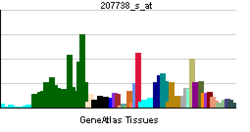- NCKAP1
-
NCK-associated protein 1 Identifiers Symbols NCKAP1; FLJ11291; HEM2; KIAA0587; MGC8981; NAP1; NAP125 External IDs OMIM: 604891 MGI: 1355333 HomoloGene: 8384 GeneCards: NCKAP1 Gene Gene Ontology Molecular function • protein binding Cellular component • plasma membrane
• integral to membrane
• lamellipodium membrane
• cell projectionBiological process • apoptosis
• central nervous system developmentSources: Amigo / QuickGO RNA expression pattern 
More reference expression data Orthologs Species Human Mouse Entrez 10787 50884 Ensembl ENSG00000061676 ENSMUSG00000027002 UniProt Q9Y2A7 P28660 RefSeq (mRNA) NM_013436.3 NM_016965.2 RefSeq (protein) NP_038464.1 NP_058661.1 Location (UCSC) Chr 2:
183.79 – 183.9 MbChr 2:
80.34 – 80.42 MbPubMed search [1] [2] Nck-associated protein 1 is a protein that in humans is encoded by the NCKAP1 gene.[1][2][3][4]
Interactions
NCKAP1 has been shown to interact with RAC1[5] and ABI1.[6]
References
- ^ Suzuki T, Nishiyama K, Yamamoto A, Inazawa J, Iwaki T, Yamada T, Kanazawa I, Sakaki Y (Apr 2000). "Molecular cloning of a novel apoptosis-related gene, human Nap1 (NCKAP1), and its possible relation to Alzheimer disease". Genomics 63 (2): 246–54. doi:10.1006/geno.1999.6053. PMID 10673335.
- ^ Eden S, Rohatgi R, Podtelejnikov AV, Mann M, Kirschner MW (Aug 2002). "Mechanism of regulation of WAVE1-induced actin nucleation by Rac1 and Nck". Nature 418 (6899): 790–3. doi:10.1038/nature00859. PMID 12181570.
- ^ Matuoka K, Miki H, Takahashi K, Takenawa T (Nov 1997). "A novel ligand for an SH3 domain of the adaptor protein Nck bears an SH2 domain and nuclear signaling motifs". Biochem Biophys Res Commun 239 (2): 488–92. doi:10.1006/bbrc.1997.7492. PMID 9344857.
- ^ "Entrez Gene: NCKAP1 NCK-associated protein 1". http://www.ncbi.nlm.nih.gov/sites/entrez?Db=gene&Cmd=ShowDetailView&TermToSearch=10787.
- ^ Kitamura, Y; Kitamura T, Sakaue H, Maeda T, Ueno H, Nishio S, Ohno S, Osada S i, Sakaue M, Ogawa W, Kasuga M (Mar. 1997). "Interaction of Nck-associated protein 1 with activated GTP-binding protein Rac". Biochem. J. (ENGLAND) 322 ( Pt 3) (Pt 3): 873–8. ISSN 0264-6021. PMC 1218269. PMID 9148763. http://www.pubmedcentral.nih.gov/articlerender.fcgi?tool=pmcentrez&artid=1218269.
- ^ Yamamoto, A; Suzuki T, Sakaki Y (Jun. 2001). "Isolation of hNap1BP which interacts with human Nap1 (NCKAP1) whose expression is down-regulated in Alzheimer's disease". Gene (Netherlands) 271 (2): 159–69. doi:10.1016/S0378-1119(01)00521-2. ISSN 0378-1119. PMID 11418237.
Further reading
- Kitamura T, Kitamura Y, Yonezawa K et al. (1996). "Molecular cloning of p125Nap1, a protein that associates with an SH3 domain of Nck". Biochem. Biophys. Res. Commun. 219 (2): 509–14. doi:10.1006/bbrc.1996.0264. PMID 8605018.
- Kitamura Y, Kitamura T, Sakaue H et al. (1997). "Interaction of Nck-associated protein 1 with activated GTP-binding protein Rac". Biochem. J. 322 ( Pt 3) (Pt 3): 873–8. PMC 1218269. PMID 9148763. http://www.pubmedcentral.nih.gov/articlerender.fcgi?tool=pmcentrez&artid=1218269.
- Kobayashi K, Kuroda S, Fukata M et al. (1998). "p140Sra-1 (specifically Rac1-associated protein) is a novel specific target for Rac1 small GTPase". J. Biol. Chem. 273 (1): 291–5. doi:10.1074/jbc.273.1.291. PMID 9417078.
- Witke W, Podtelejnikov AV, Di Nardo A et al. (1998). "In mouse brain profilin I and profilin II associate with regulators of the endocytic pathway and actin assembly". EMBO J. 17 (4): 967–76. doi:10.1093/emboj/17.4.967. PMC 1170446. PMID 9463375. http://www.pubmedcentral.nih.gov/articlerender.fcgi?tool=pmcentrez&artid=1170446.
- Nagase T, Ishikawa K, Miyajima N et al. (1998). "Prediction of the coding sequences of unidentified human genes. IX. The complete sequences of 100 new cDNA clones from brain which can code for large proteins in vitro". DNA Res. 5 (1): 31–9. doi:10.1093/dnares/5.1.31. PMID 9628581.
- Yamamoto A, Suzuki T, Sakaki Y (2001). "Isolation of hNap1BP which interacts with human Nap1 (NCKAP1) whose expression is down-regulated in Alzheimer's disease". Gene 271 (2): 159–69. doi:10.1016/S0378-1119(01)00521-2. PMID 11418237.
- Strausberg RL, Feingold EA, Grouse LH et al. (2003). "Generation and initial analysis of more than 15,000 full-length human and mouse cDNA sequences". Proc. Natl. Acad. Sci. U.S.A. 99 (26): 16899–903. doi:10.1073/pnas.242603899. PMC 139241. PMID 12477932. http://www.pubmedcentral.nih.gov/articlerender.fcgi?tool=pmcentrez&artid=139241.
- Salazar MA, Kwiatkowski AV, Pellegrini L et al. (2004). "Tuba, a novel protein containing bin/amphiphysin/Rvs and Dbl homology domains, links dynamin to regulation of the actin cytoskeleton". J. Biol. Chem. 278 (49): 49031–43. doi:10.1074/jbc.M308104200. PMID 14506234.
- Fujita F, Taniguchi Y, Kato T et al. (2003). "Identification of NAP1, a Regulatory Subunit of IκB Kinase-Related Kinases That Potentiates NF-κB Signaling". Mol. Cell. Biol. 23 (21): 7780–93. doi:10.1128/MCB.23.21.7780-7793.2003. PMC 207563. PMID 14560022. http://www.pubmedcentral.nih.gov/articlerender.fcgi?tool=pmcentrez&artid=207563.
- Ota T, Suzuki Y, Nishikawa T et al. (2004). "Complete sequencing and characterization of 21,243 full-length human cDNAs". Nat. Genet. 36 (1): 40–5. doi:10.1038/ng1285. PMID 14702039.
- Innocenti M, Zucconi A, Disanza A et al. (2004). "Abi1 is essential for the formation and activation of a WAVE2 signalling complex". Nat. Cell Biol. 6 (4): 319–27. doi:10.1038/ncb1105. PMID 15048123.
- Mayne M, Moffatt T, Kong H et al. (2004). "CYFIP2 is highly abundant in CD4+ cells from multiple sclerosis patients and is involved in T cell adhesion". Eur. J. Immunol. 34 (4): 1217–27. doi:10.1002/eji.200324726. PMID 15048733.
- Jin J, Smith FD, Stark C et al. (2004). "Proteomic, functional, and domain-based analysis of in vivo 14-3-3 binding proteins involved in cytoskeletal regulation and cellular organization". Curr. Biol. 14 (16): 1436–50. doi:10.1016/j.cub.2004.07.051. PMID 15324660.
- Gerhard DS, Wagner L, Feingold EA et al. (2004). "The Status, Quality, and Expansion of the NIH Full-Length cDNA Project: The Mammalian Gene Collection (MGC)". Genome Res. 14 (10B): 2121–7. doi:10.1101/gr.2596504. PMC 528928. PMID 15489334. http://www.pubmedcentral.nih.gov/articlerender.fcgi?tool=pmcentrez&artid=528928.
- Chen W, Tang Z, Fortina P et al. (2005). "Ethanol potentiates HIV-1 gp120-induced apoptosis in human neurons via both the death receptor and NMDA receptor pathways". Virology 334 (1): 59–73. doi:10.1016/j.virol.2005.01.014. PMID 15749123.
- Ewing RM, Chu P, Elisma F et al. (2007). "Large-scale mapping of human protein–protein interactions by mass spectrometry". Mol. Syst. Biol. 3 (1): 89. doi:10.1038/msb4100134. PMC 1847948. PMID 17353931. http://www.pubmedcentral.nih.gov/articlerender.fcgi?tool=pmcentrez&artid=1847948.
Categories:- Human proteins
- Chromosome 2 gene stubs
Wikimedia Foundation. 2010.
